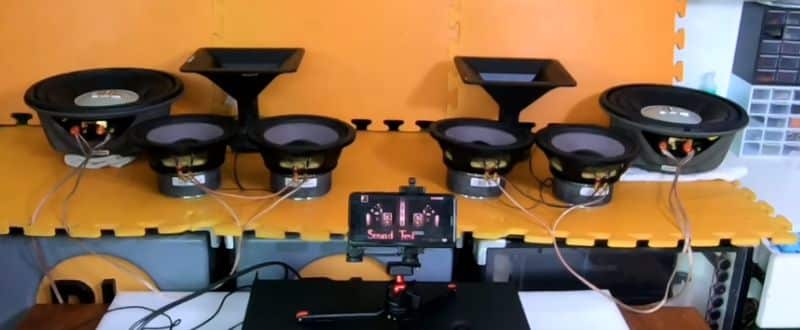For any car audio enthusiast, achieving top-notch sound quality involves delving into intricate setups by combining a monoblock amp with speakers. It can often push your thoughts about the boundaries of what can be done in a car’s sound environment.
One of those configurations stands out and makes you question how to connect 6 speakers to a 1 channel amp. This setup unlocks a realm of acoustic possibilities that convert any ride into an extraordinary auditory experience.
This guide has the objective to get into the detailed method of the connection process to help you attain a successful result. Let’s get started to enhance your knowledge to transform your car's audio capabilities!
In This Article
Selecting the Suitable Equipment
The secret to picking the perfect tools for your audio setup hinges on aligning your speakers' specs with your amplifiers. You should pay close attention to impedance and power handling capabilities. The amplifier has to fit within these parameters to prevent overburdening the amp or degrading sound quality. Likewise, your speakers' power handling capacity should be compatible with the amplifier's output power. This harmony is key to achieving the best audio performance.
Tools You Will Require
When you're set to link six speakers with a one-channel amp in your vehicle, having the right tools is crucial. Here's a rundown of essential equipment to streamline the installation process:
- Wire Strippers: It’s essential for stripping insulation from speaker wires, ensuring clean and precise connections.
- Screwdrivers: A comprehensive set, including both flat-head and Phillips screwdrivers, will be invaluable for securing connections and navigating through speaker and amplifier compartments.
- Soldering Iron: This is an important tool for fusing wires and terminals, creating a more robust and stable connection.
- Crimping Tool: It is crucial for attaching connectors to wires, ensuring strong, dependable connections.
- Multimeter: An invaluable instrument for testing connections and accurately measuring the impedance of both speakers and amplifier impedance.
A Simplified Connection Process
A Simplified Connection Process
Let’s help you walk through the process of connecting 6 speakers to a 1 channel amp.
Step 1: Determining Speaker Impedance
You need to begin the connection process by identifying each speaker's impedance (measured in ohms). All speakers should have the same impedance to balance the load across the amplifier (whose range generally is from 4 to 16 ohms). The mono amplifier should have an appropriate impedance level to let you achieve a sustainable connection.
Step 2: Select the Wiring Configuration
It's critical to select the right wiring configuration for your speakers, considering the total impedance and your personal preferences. Making an informed choice is key to preventing overloading or underutilizing the amplifier. Here's a brief overview of each configuration:
Series Wiring: In this setup, the impedance of each speaker is summed up, leading to a higher total impedance. For example, six 2-ohm speakers connected in series result in a total impedance of 12 ohms. This is ideal for amplifiers that can handle higher impedance loads. However, series wiring may reduce the overall volume output.
Parallel wiring: This configuration decreases the total impedance. The overall impedance in parallel wiring is found by dividing the individual impedance by the number of speakers. For instance, six 4-ohm speakers in parallel would yield a total impedance of about 0.67 ohms. This is suitable for amplifiers that can manage lower impedance loads and often result in a louder output.
Series-Parallel wiring: This method combines series and parallel wiring to balance the total impedance. It's particularly useful when you have multiple speakers and an amplifier with a mid-range impedance capacity. This involves creating pairs of speakers wired in series and then connecting these pairs in parallel.
Step 3: Connecting the Wires
Each wiring method - series, parallel, and series-parallel - has a distinct installation process. Here's how to approach each:
A. Series Wiring
You need to begin by identifying the positive and negative terminals of each speaker. The next thing to do is to connect them sequentially: the negative terminal of the first speaker to the positive terminal of the second, and so forth, creating a chain. Finally, link the free positive terminal of the first speaker and the free negative terminal of the last speaker directly to the amplifier.

In this hypothetical example, a 12-ohm amp would be required to connect 6 speakers of 2 ohms each. It can vary proportionately for different equipment in your case.
B. Parallel Wiring
In a parallel wiring installation, the process begins similarly by identifying each speaker's positive and negative terminals. Here, you'll connect all the speakers’ positive terminals and do the same with the speakers’ negative terminals. These combined terminals are then connected to the amplifier's corresponding positive and negative terminals.

In this case, a least of 4 ohms is taken as the mono amps come at 4-16 ohms. But the need for the parallel series mono amp was less than that, and you can also take a more powerful monoblock amp.
C. Series-Parallel Wiring
The series-parallel wiring connection involves initially dividing the six speakers into three pairs. You need to connect one speaker's positive terminal to the other’s negative terminal within each pair. The next thing to do is to connect all the free positive terminals of these pairs together and repeat the process for the negative terminals. These grouped terminals are then connected to the respective terminals on the amplifier.

This setup required a mono amp of at least 12 ohms, but 16 ohm-one will also work fine.
Step 4: Testing and Troubleshooting
After connecting the 6 speakers to the monoblock amplifier using the chosen wiring configuration, testing the setup for functionality and sound quality is a must. You can start by powering the system at a low volume. Try to listen to each speaker individually to ensure they are all producing sound.
Do look out for any signs of distortion or imbalance in the sound. The distortion often indicates an issue with the wiring connections or a mismatch in impedance. An imbalance in sound could be due to incorrect wiring, especially in a series-parallel setup where each speaker’s position in the configuration can affect the sound output.
If a particular speaker is quieter than the others or not working at all, recheck its connections. Ensure that the terminals are securely connected and there is no short-circuiting due to exposed wires. You need to double-check that the speakers are wired according to the plan and that none of the connections are loose.
Best Practices to Keep in Mind
The best practices for a safe connection of a mono amp to 6 speakers include:
- You should prioritize compatibility in case of impedance to prevent any kind of damage to your system.
- It's crucial to use high-quality speaker wires of the appropriate gauge, as it enhances sound transmission and ensures the durability of your system.
- Make certain that all connections are tight and properly insulated. This precaution is vital to prevent short circuits, which can cause damage to your system.
- Maintain neat cable routing as it not only helps in avoiding tangles but also minimizes the risk of potential damage to the wires.
Wrapping Up
With this guide, you've delved into the intricate process of connecting 6 speakers to a monoblock amplifier in a car audio system. The journey involves understanding speaker impedance and amplifier load and choosing the correct wiring configurations. Remember, creating a well-balanced sound system demands patience, meticulous attention to detail, and a commitment to doing what's necessary for optimal results.
Related Posts:

